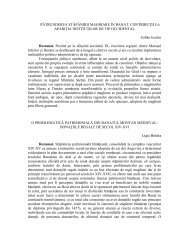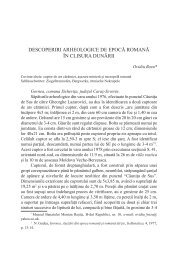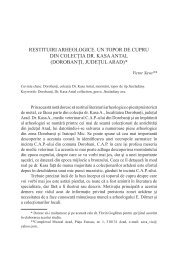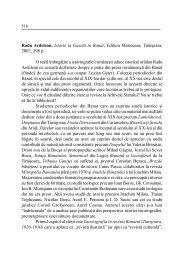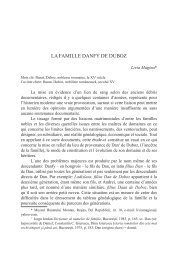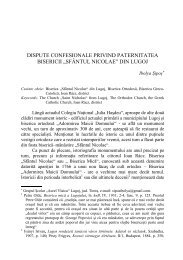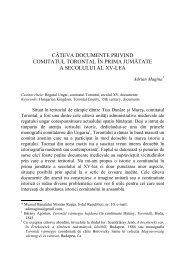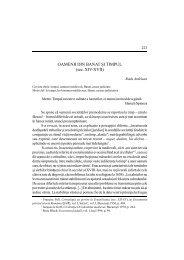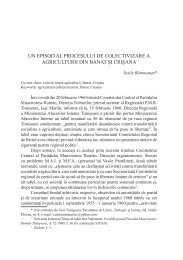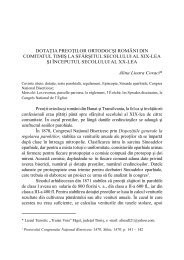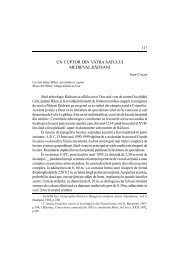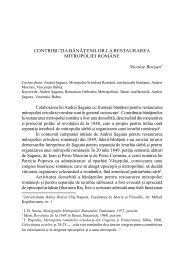jOHN HUNYADI BETwEEN BELGRADE AND CETATEA ... - Banatica
jOHN HUNYADI BETwEEN BELGRADE AND CETATEA ... - Banatica
jOHN HUNYADI BETwEEN BELGRADE AND CETATEA ... - Banatica
You also want an ePaper? Increase the reach of your titles
YUMPU automatically turns print PDFs into web optimized ePapers that Google loves.
50<br />
1. john Hunyadi’s Danubian and Pontic Interests and the Moldavian<br />
Question after 1448<br />
In August 1451, king Casimir IV of Poland requested 50.000 Turkish<br />
aspers a year (asides probably Moldavia’s normal Polish census) for the<br />
recognition of Bogdan II’s perhaps (potentially) life-long rule 42 . The sum stood<br />
for some 1.500 ducats, 75% of the tribute the Moldavian ruler (by then back in<br />
control over Cetatea Albă) had to pay to the sultan after 1455 43 . The Ottoman<br />
impact on Poland and Moldavia was in fact great prior to 1453. Both in 1450<br />
and in 1451, Polish financial demands from Bogdan II had been calculated in<br />
aspers 44 . A incident can therefore be of interest.<br />
The value of the goods lost by the Senarega family following the<br />
Moldavian ‘conquest’ of Ilice (at the Dniepr Mounds) in spring 1455, was<br />
estimated at 10.000 Venetian ducats or 14.000 Turkish aspers. This leads to<br />
a ratio of 1:1.4, more than 20 times below the usual exchange rate, a rather<br />
unlikely situation. On the other hand, the natural possibility arises that, in<br />
Moldavia, as well as in the Crimean Peninsula, exchange rates were more<br />
favorable for the asper, offering an important advantage to the increasingly<br />
stronger northern position of Ottoman trade and politics 45 .<br />
john Hunyadi, Bogdan II and the Question of Elias I’s and Stephen II’s<br />
Heritage<br />
Five years earlier, Bogdan II however had no major access to Pontic<br />
trade. Since 1450, the (Moldavian) castellan of Cetatea Albă militarily<br />
supported Alexander II’s claims. Due to the strong position of the local<br />
42 [jan Długosz], Jan Dlugosii Senioris Canonici Cracoviensis Opera omnia, (ed. Alexander<br />
Przezdziecki), XIII-XIV, Historiae Polonicae libri XII, krakow, 1883-1887, p. 91, 100;<br />
(henceforth: Długosz 1887).<br />
43 Documente turceşti privind istoria României, I, 1417-1774, (ed. M.A. Mehmed), Bucureşti,<br />
1976, no. 1, p. 2.<br />
44 Franz Babinger, Zur Frage der osmanischen Goldprägungen im 15. Jahrhundert unter<br />
Murâd II. und Mehmed II, in SF, XV, (1956), p. 550-553; Şevket Pamuk, Money in the<br />
Ottoman Empire. 1326-1914, in An Economic and Social History of the Ottoman Empire<br />
1300-1914, (ed. Halil Inalcik), Cambridge, 1994, p. 951-956; Ernest Oberländer-Târnoveanu,<br />
Notes on the Genoese Coinage at Pera during the First Half of the 15th Century, in Etudes<br />
Byzantines et Post-Byzantines, V, 2006, p. 377-385.<br />
45 Most of the data on these matters can be found in Nicolae Iorga, Acte şi fragmente cu privire<br />
la istoria românilor, III, [1399-1499] Bucureşti, 1897, p. 32-36.



